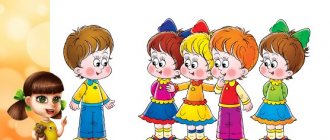The essence of game teaching methods
Game methods have an advantage over other teaching methods, since they are interesting to children and attract attention from the very beginning. Game methods are based on various games that evoke positive emotions that help create a comfortable psychological situation in the learning process. The use of game methods in teaching significantly reduces the cost of nervous energy and volitional efforts.
Are you an expert in this subject area? We invite you to become the author of the Directory Working Conditions
In the process of studying the use of game teaching methods, it was found that these methods help to enhance the mental and motor activity of students. Motor activity has a positive effect on the formation of associative connections that facilitate the process of acquiring knowledge and skills. During play, a child’s perception processes proceed much faster and more accurately.
Game teaching methods have a number of characteristic features:
- The educational material or educational action acquires a conditional plan, which is transferred to the game scenario.
- The game method requires the participation of all participants in the learning process in the game, that is, both students and the teacher participate in the game, which contributes to the direct learning influence on children through comments, instructions, directions, reprimands, tips, etc.
Game methods are very diverse. Their variety depends on the type of game used by the teacher. Regardless of what kind of game is used, the method has two main pedagogical functions:
- Improving and consolidating knowledge. During the game, the child has to use previously acquired knowledge, transform it if necessary, transform it, and learn to operate with his knowledge and skills. All this has a positive impact on expanding and deepening students' knowledge.
- Successful acquisition of new knowledge and skills of varying complexity and content. During the game, most often, in order to assimilate new knowledge, the teacher uses various imaginary situations in an expanded form, using gaming equipment and corresponding game actions and roles. For example, in order to improve and expand knowledge about decorative and applied arts, games “Exhibition”, “Souvenir Shop”, “Journey to the Past”, etc. can be played.
Finished works on a similar topic
Course work Game-based teaching methods 460 ₽ Abstract Game-based teaching methods 260 ₽ Examination Game-based teaching methods 200 ₽
Receive completed work or specialist advice on your educational project Find out the cost
The selection of the type of games for the use of game methods in teaching depends on the age of the students, their psychological and physical development, individual capabilities and needs. Taking into account these criteria will help the teacher select truly effective games that will help enhance the pedagogical impact on students and obtain high learning results.
Thus, the role of game teaching methods in the pedagogical process is quite large. The effectiveness of these methods depends on the professional skills of the teacher, his understanding of the functions of educational games and their importance in the upbringing and teaching of children.
“The use of gaming techniques in the development of motor creativity and independence of the child.”
Author: Abramova Valentina Mikhailovna
The game method reflects the methodological features of games and game exercises, which are widely used in physical education. It is close to the child’s leading activity and provides an opportunity to improve motor skills. When working with children, story-based and non-plot games, as well as sports games, are widely used.
The game method makes it possible to improve motor skills, independent actions, manifestation of independence and creativity. Playful activities develop cognitive abilities, moral and volitional qualities, and shape the child’s behavior. This method is most actively used in younger groups, but it is also widely used in work with older preschoolers.
Outdoor games develop the ability to adequately assess spatial and temporal relationships, simultaneously perceive many things and respond to what is perceived.
Playing with various small objects is no less important. Exercises with balls, bags, etc. increase the skin-tactile and muscle-motor function of the hands and fingers, which is of particular importance for preschool children.
In outdoor games, participants have to perform different roles
(driver, referee, assistant referee, game organizer, etc.), which develops their organizational skills.
Outdoor games create an atmosphere of joy and therefore make the most effective complex solution to health, educational and educational problems.
Active movements, determined by the content of the game, evoke positive emotions in children and enhance all physiological processes.
Situations on the playground, which change all the time, teach children to use motor skills appropriately, ensuring their improvement. Physical qualities naturally manifest themselves - reaction speed, dexterity, eye, balance, spatial orientation skills, etc.
The need to obey the rules and respond appropriately to a signal organizes and disciplines children, teaches them to control their behavior, develops intelligence, motor initiative and independence.
Outdoor games broaden children’s general horizons, stimulate the use of knowledge about the world around them, human actions, and animal behavior; replenish vocabulary; improve mental processes.
Outdoor games - a school of movements. Therefore, as children gain motor experience, games need to be made more complex. In addition, increasing complexity makes familiar games interesting for children.
In early preschool age, play techniques are widely used when teaching children various movements. Which lead to an emotional and figurative clarification of ideas about the nature of movements. for example, when children are told: “Run quietly, like mice. Jump. Like bunnies."
To interest children in outdoor games, teachers widely use playing with toys, objects and pictures, riddles, poems and other small artistic genres. This helps to gather children for the game and arouse their interest in the content.
Organizing children requires great resourcefulness from the teacher, because they also need to be taught to play and develop an interest in outdoor games. Therefore, the leader, attracting the attention of the kids, demonstratively plays with the ball, accompanying the movements with poetry: “My cheerful ringing ball...”, or spins around, holding hands with the birthday boy or doll and singing the song “Loaf”; or, approaching the children, in a mysterious voice he offers to see whose ears are sticking out behind the bush, and the house drawn on the playground, where the teacher invites them, looks like a real one - with a roof and a chimney...
Children of middle preschool age love and know how to play. You can agree with them on the place and signal for collection long before the start of the walk. Young children do not accept such methods. Children can be gathered directly on the playground with the help of barkers (One! Two! Three! Play, hurry up, run!; One, two, three, four, five! I call everyone to play!”, etc.) You can In an interesting way, instruct individual children to collect the rest within a set limited time (while the spinning top is spinning, a melody is sounding, attributes are being placed). You can use non-standard sound and visual signals (a sports whistle, a bell, a bunch of inflatable balloons, a flannelograph, etc.) Surprise moments are effective: those who can run under a rotating jump rope, who can slide along an ice path, etc. will play.
Undoubtedly, a differentiated approach is needed here, because some children are more interested in playing games of a sports nature, others - in plot games with bright roles, figurative texts, and still others - in plotless games - competitions. relay races Games – fun with objects (skittles, etc.). Should be considered:
1. The inclinations and interests of a particular child (for example, create such a subject environment in order to attract him to games that are interesting to him
or movements, select the necessary attributes, determine the place for the game).
2. The child’s capabilities, the level of his abilities (in organized games, a child without the proper level of development of motor skills, initiative, independence, communication skills will feel insecure, will not be able to creatively solve a motor task in changing situations, and, if necessary, find a compromise when choosing a game , distribution of roles, etc.). It should be remembered: play creativity in outdoor games develops unevenly, contradictorily, the individual characteristics of children are especially noticeable here, moreover, the same child can show different levels of creativity depending on the content of the game, his role, and relationships with friends. If the goal of the game, the very prospect of active motor activity, is interesting to preschoolers, then it will be easier to teach them to think about both the preparation and organization of the game (how to get together, agree on the game, how to distribute roles, monitor compliance with the rules, etc.). In such a collective outdoor game, as in other creative activities, ideas, plans, and plans collide. This often gives rise to disputes, the resolution of which the teacher can use to develop in children respect for the opinions of others, fairness, and to form personality traits.
An important role in the development of children’s creative activity is played by involving them in creating variants of games and complicating the rules. It is advisable to carry out this work starting with the older group. The teacher first himself, and then involving the children in this, presents them with familiar games in different versions. Such variability will not only support interest in motor activity and improve motor skills, but will also enrich the motor play experience of preschoolers, teach them to creatively perform well-known actions and solve new problems. This can be done. Creating problem-search situations: “How to play differently?” You should not dwell on the same areas of variation in the game. For example, in addition to the well-known complication of methods of performing movements or introducing additional motor tasks, it is useful to introduce children to the variation of rules, structures of players, quantitative parameters of movements, number of roles, ways of embodying game images, as well as the choice of physical education equipment and paraphernalia, location of the game, etc. .d.
At first, the leading role in varying games belongs to the teacher, but gradually children are given more and more independence. After this, children are invited to come up with game options themselves. The most interesting ones are selected from the proposed options.
When varying the game, you cannot change the design and composition of the game, but you can:
1. increase the dosage (repetition and total duration of the game);
2. complicate motor content (sparrows do not run out of the house, but jump out).
3. change the placement of players on the court (the trap is not on the side, but in the middle of the court).
4. change the signal (instead of Slovenian - audio or visual).
5. play the game in non-standard conditions (it’s more difficult to run in the sand; in the forest, running away from a trap, you can hang, clasping a tree trunk with your arms and legs);
6. complicate the rules (in the older group, those caught can be rescued; increase the number of traps, etc.).
Thus, an indicator of children's creativity in the game is not only the speed of reaction, the ability to enter into a role, conveying their understanding of the image, independence in solving motor problems in connection with a change in the game situation, but also the ability to create combinations of movements, game options, and complicate the rules. The highest manifestation of creativity in children is their inventing new outdoor games and the ability to organize them independently.
Coming up with new outdoor games is not something all children can do. The reasons for this may be individual characteristics, the level of motor and social experience and the overorganization of the pedagogical process, which does not always sufficiently encourage the child to be creative.
Each time, using different methods, depending on the age of the children, to gather them for the game, to create interest in it, and to distribute roles. Methods of assessment and summing up at its end, the teacher creates in students a positive potential for means of self-organization for joint games, creative self-expression in them during free
(independent) motor activity. You should resort to various forms of organizing outdoor games (collective, group, individual) and introduce them not only in the process of organized learning (classes), but also in independent activities, gradually encouraging you to come up with appropriate games yourself.
The leader must state the rules of the game briefly, since children strive to reproduce everything outlined in the actions as quickly as possible. Often, without listening to the explanation, children express a desire to play one or another role in the game. It’s not bad if the leader talks about the game in the form of a fairy tale, which is perceived by children with great interest and contributes to the creative performance of roles in it. This method can be used to better assimilate the game when children are inattentive or when they need rest after physical activity.
Creative outdoor games are games created (invented) by children themselves based on paintings and familiar literary works.
To foster creative independence in children, it is necessary to equip the teacher with the appropriate methodology.
To conduct meaningful and effective outdoor games with children, it is necessary to carry out a lot of preparatory work. First of all, when teaching children motor actions, their creative activity should be formed. This will ensure independence in the use of motor skills in the game. It is also important to expand children’s knowledge and ideas about the environment. To do this, children are introduced to the actions of various characters, read relevant literature, and look at paintings. It is necessary to conduct conversations, clarify their ideas about game characters, teach them to highlight an episode with movements in listened fairy tales, stories, causing an emotional experience, a desire to display this episode in the game. It is advisable to offer this episode in different versions, involving children in improvisation. In search of solutions to certain problems in outdoor games, children are invited to come up with their own action. Actions that are different from other children, new rules, and solve a motor problem in your own way. Setting appropriate tasks and solving them contributes not only to conscious, creative movement, but also to the development of children’s mental abilities. comments powered by HyperComments
Types of pedagogical impact of game teaching methods
Game teaching methods include a variety of pedagogical games.
Definition 2
Pedagogical games are games that have a specific educational goal and a corresponding pedagogical result.
Pedagogical games are varied and vary depending on:
- didactic content;
- organizational structure;
- age capabilities of children;
- content specifics.
Games used as part of the game teaching method are classified according to the type of pedagogical impact on students:
- Didactic games are aimed at expanding the horizons of students, their cognitive activity, and the formation of specific skills and abilities necessary for the successful implementation of various types of activities.
- Games of educational influence are aimed at developing in students will, independence, various life attitudes (moral, aesthetic, worldview), the ability to cooperate and interact in a team.
- Developmental games are aimed at developing students’ speech, thinking, memory, attention, fantasy, imagination and other various creative skills, as well as developing motivation for learning and acquiring new knowledge.
- Games that have a socializing effect are aimed at familiarizing students with the norms and rules of behavior within modern society, developing the ability to adapt to new conditions, effectively interact and communicate with others, and master the skills of self-regulation and self-control.
Note 1
Thus, game teaching methods are very diverse and are aimed at the comprehensive education and development of students through various types of pedagogical influence.
Types of pedagogical games
Each gaming technology consists of individual techniques - that is, games. There are many types of them, which allows you to flexibly choose teaching tools and combine them with didactic techniques for a deeper immersion in the topic. Games are classified according to several criteria:
- according to the “resources” of the students involved in it - games can be physical, mental, emotional and psychological, or combined;
- by type of pedagogical process - educational, communicative, cognitive, reproductive;
- by type and method of organizing the process - questioning and testing, competition and competition, theatrical performance and dramatization game, holiday, training;
- according to the level of severity of the rules - with pre-established frameworks, with conditions determined during the game and improvisational;
- on the construction of the process - plot, role, subject, simulation, business.
Games can use sports equipment, objects, computer equipment or virtual space. Most often, strict rules are set for physical and intellectual forms. The free flow of the process is inherent in creative types - musical, theatrical, festive. The teacher determines the specifics and additional conditions of the game, focusing on the characteristics of the students (pupils) and the material being studied.
To properly use games in the educational process, special education is required. His main areas are preschool and school pedagogy, social and pedagogical activities, and teaching in primary grades. You can get such an education at ANPOO "NSPK". You can learn more about distance* programs from the college admissions office.
* Form of study – correspondence. Educational programs are implemented using e-learning and distance learning technologies.






